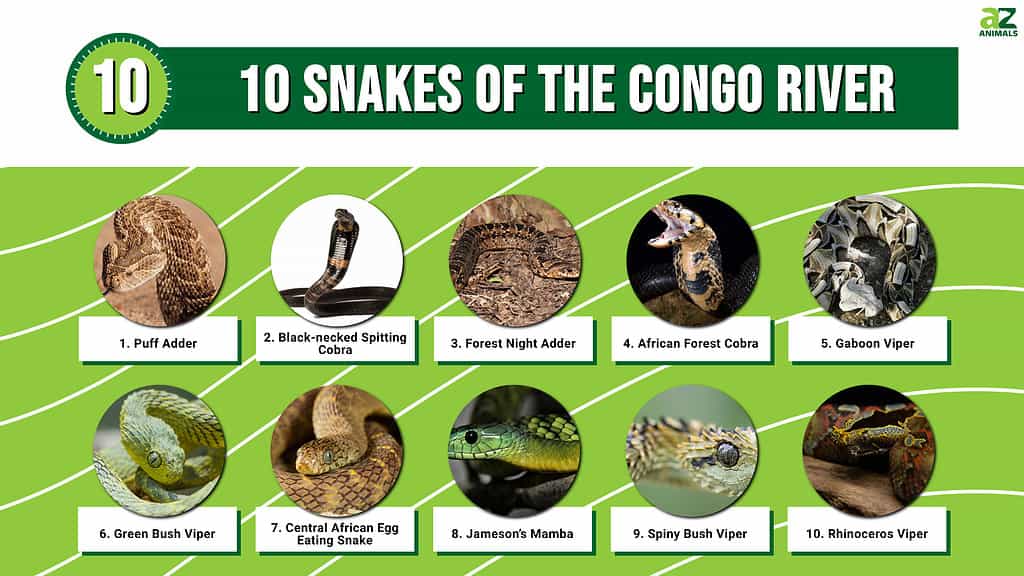
The Congo River is one of the longest rivers in the world. In Africa, it’s second only to the Nile River. By discharge volume, it’s second only to the Amazon River in South America. With nearly 3,000 miles of waterways, the snakes of the Congo River have plenty of space to spread out. There are many species of snake living in the Congo River drainage, some of which are highly dangerous.
Here, we’ll discover ten of the most interesting snakes of the Congo River. We’ll learn about their looks, hunting strategies, and favorite foods. We’ll also learn whether or not they’re dangerous and whether they live on the ground or high in the trees.
Keep reading to learn more about the snakes of the Congo River!
1. Puff Adder

These snakes live in many parts of
Africa
; they’re responsible for many snakebites on humans yearly.
©iStock.com/EcoPic
Puff adders are one of the most widespread snakes in Africa. They grow up to 60 inches long and have heavy, rattlesnake-like bodies. They’re terrestrial (ground dwelling) with scales in shades of light, medium, and dark brown that help them blend in. These snakes primarily come out at night to hunt a wide variety of prey, including lizards, birds, mammals, and amphibians. Puff adders have potent venom, which they readily inject in self-defense when threatened.
2. Black-necked Spitting Cobra

These snakes live throughout sub-Saharan Africa; their venom is potent enough to kill humans who don’t receive prompt medical attention.
©Scott Delony/Shutterstock.com
Black-necked spitting cobras of the Congo River grow up to seven feet long. They’re almost entirely black, except for some pale underside markings. Also, like the North American cottonmouth, they display bright white mouth interiors. Capable of killing humans with their venom, these snakes can both spit and inject venom. They’re known to defend themselves aggressively and don’t hesitate to spit in self-defense. Black-necked spitting cobras eat mostly small mammals.
3. Forest Night Adder
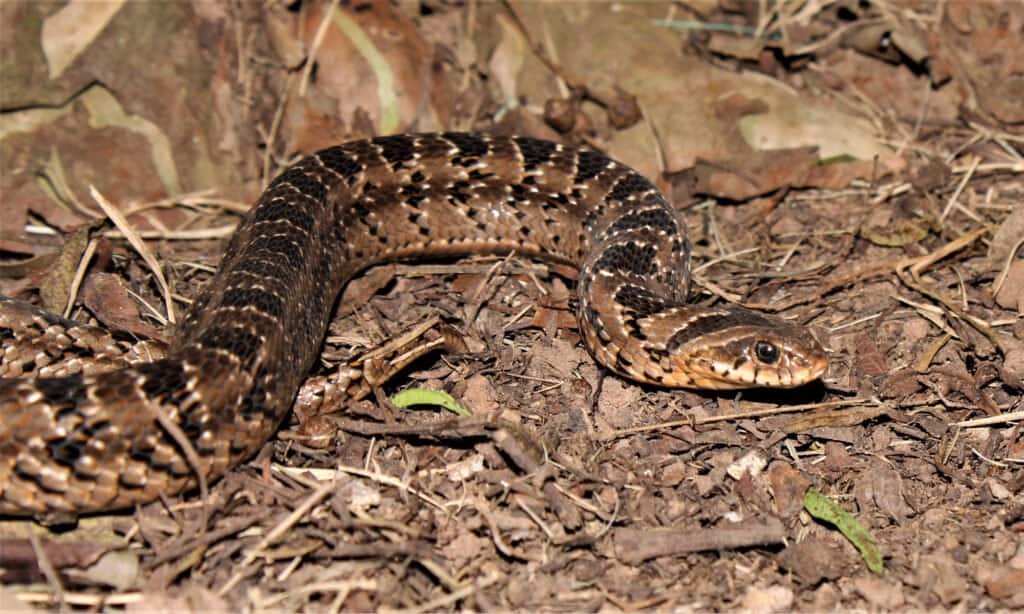
Also known as the West African night adder, spotted night adder, or forest rhombic night adder, these snakes come out only at night.
©Cormac Price/Shutterstock.com
Forest night adders are small, with the largest specimens growing to just over two feet long. They’re generally brown to gray-green or olive-green, with some black markings and pale bellies. These snakes stick to the forest floor, where they hunt primarily toads and frogs. Forest night adders are venomous, though their venom is not generally life-threatening.
4. African Forest Cobra
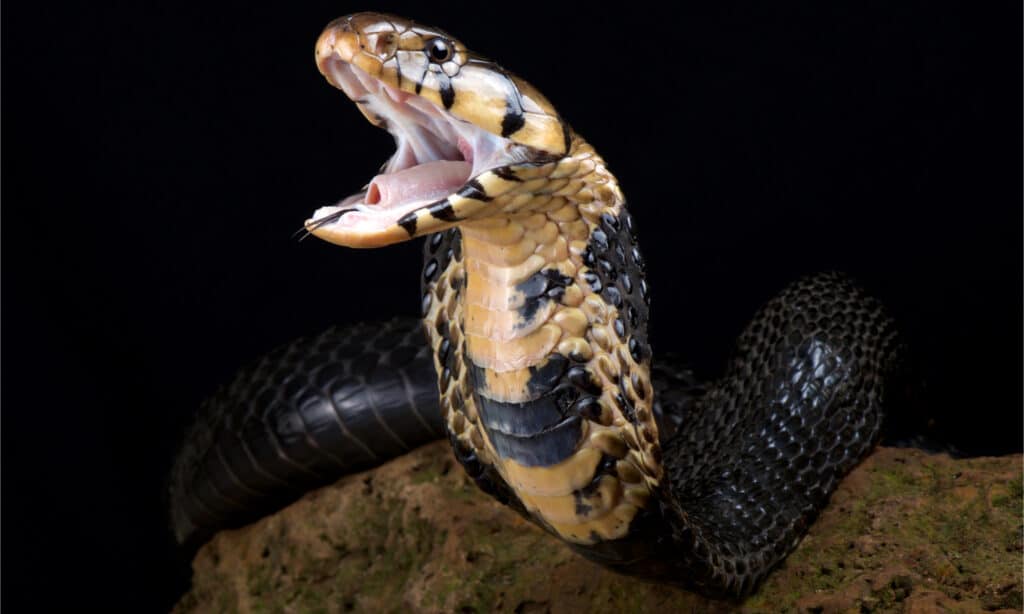
African forest cobras have deadly bites that can lead to serious complications and even death.
©reptiles4all/Shutterstock.com
These snakes of the Congo River grow up to ten feet long and are known as the largest true cobras. They have highly potent venom, which they can both spit and inject. African forest cobras are easily recognized by the thick black and white stripes on their upper bodies. Their lower bodies have white undersides and black sides and backs. They eat lizards, frogs, toads, fish, and bird eggs.
5. Gaboon Viper
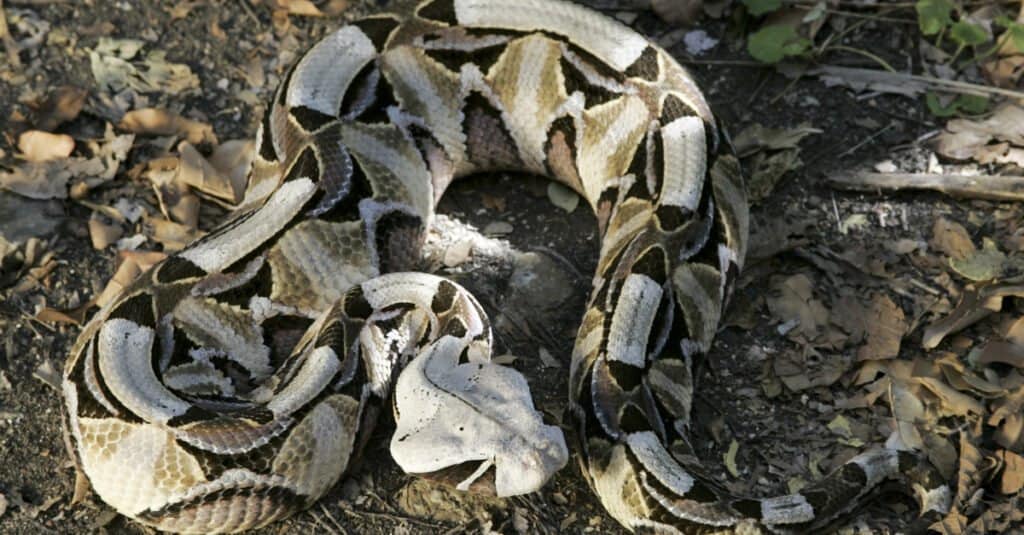
These snakes have the distinction of having the longest fangs of any venomous snake in the world.
©Stu Porter/Shutterstock.com
Gaboon vipers are some of the heaviest, deadliest snakes in the world. Strictly terrestrial, these snakes of the Congo River exhibit almost every color of brown in their coloration. They have complex patterns made up of diamonds, bars, squares, and triangles. This patterning allows them to blend into the forest floor, where they hunt small mammals, rats, and porcupines. They’re highly venomous but docile in nature; most bites occur when people accidentally step on them.
6. Green Bush Viper

One of the most unique-looking snakes on the planet, the green bush viper is also known as the leaf viper, or Hallowell’s green tree viper.
©Will E. Davis/Shutterstock.com
These small snakes of the Congo River grow up to 30 inches long. Like all vipers, they have vertically elliptical pupils and triangular heads. Green bush vipers’ scales are pointed and stand out somewhat from the body, making them look like spike-covered snakes. These snakes are active at night and eat mainly small mammals they find on the ground.
7. Central African Egg Eating Snake

Unsurprisingly, Central African egg-eating snakes are omnivores.
©Joe McDonald/Shutterstock.com
African egg-eating snakes of the Congo River are medium brown with yellow highlights and short snouts. They live in trees and grow up to several feet long. What makes these snakes so unique is their diet: they eat only bird’s eggs, straight from the nest. Despite their appearance, these snakes are not venomous, though they have evolved to look like venomous snakes.
8. Jameson’s Mamba
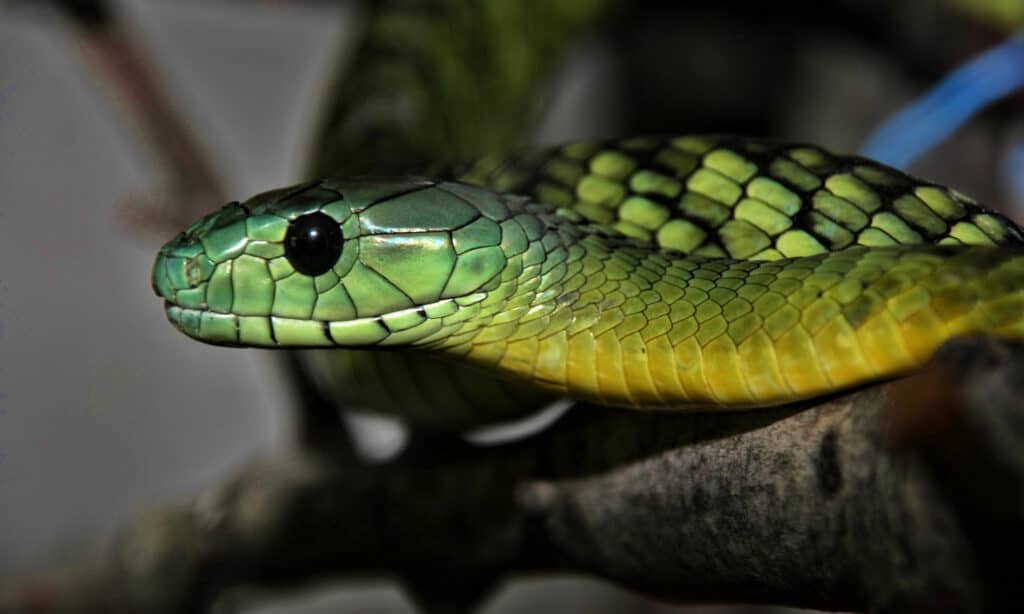
These snakes are found only in Central Africa. They’re highly venomous, with bites that can easily kill a human if left untreated.
©Vladislav T. Jirousek/Shutterstock.com
These snakes of the Congo River grow up to 7.5 feet long, with slender bodies designed for an arboreal (tree-dwelling) lifestyle. Jameson’s mambas have bright green bodies that end in black tails, with bright yellow to tan bellies. They eat mostly small mammals and birds, which they envenomate with their potent neurotoxic venom.
9. Spiny Bush Viper
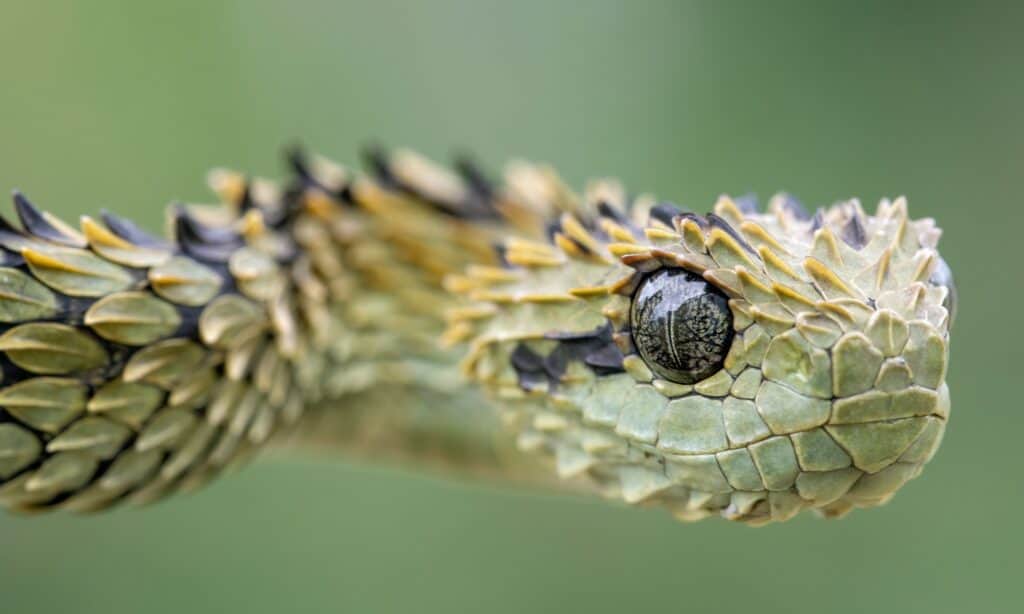
Also known as the hairy bush viper, or rough-scaled bush viper, these snakes get their name from their highly characteristic scales.
©iStock.com/Mark Kostich
Spiny bush vipers grow up to 29 inches long and spend their lives in trees. They’re yellow-green to brown in color, with pointed scales that stand up from their bodies. These scales are particularly upright near their heads, giving spiny bush vipers a dragon-like appearance. Like all vipers, they’re highly venomous.
10. Rhinoceros Viper
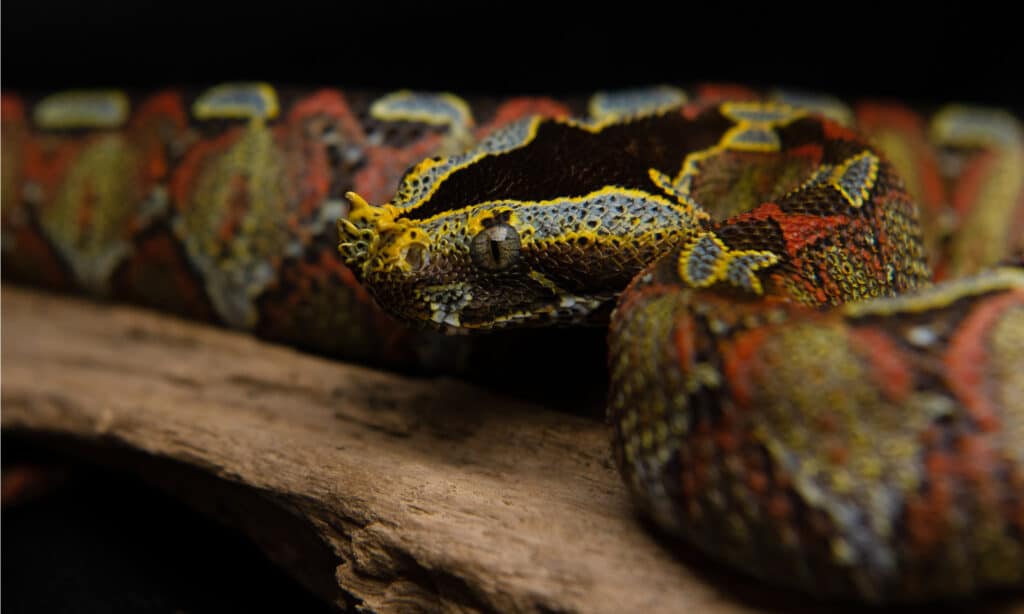
Closely related to the Gaboon viper,
rhinoceros
vipers are also known as river jacks or butterfly vipers.
©Olivia Lundborg/Shutterstock.com
Named for the hornlike scales on their noses, these snakes of the Congo River grow up to 48 inches long and have heavy bodies. They’re built for life on the ground. Combinations of yellow, brown, red, and green scales in varying patterns make the rhinoceros viper almost impossible to see among the leaf litter of the forest floor. These snakes eat small mammals, amphibians, and occasionally fish and are highly venomous.
Summary Of The 10 Snakes Of The Congo River
| # | Snake | Venomous? |
|---|---|---|
| 1 | Puff Adder | Venomous |
| 2 | Black-necked Spitting Cobra | Venomous |
| 3 | Forest Night Adder | Venomous |
| 4 | African Forest Cobra | Venomous |
| 5 | Gaboon Viper | Venomous |
| 6 | Green Bush Viper | Venomous |
| 7 | Central African Egg-Eating Snake | Non-Venomous |
| 8 | Jameson’s Mamba | Venomous |
| 9 | Spiny Bush Viper | Venomous |
| 10 | Rhinoceros Viper | Venomous |
Other Reptiles Of The Congo River
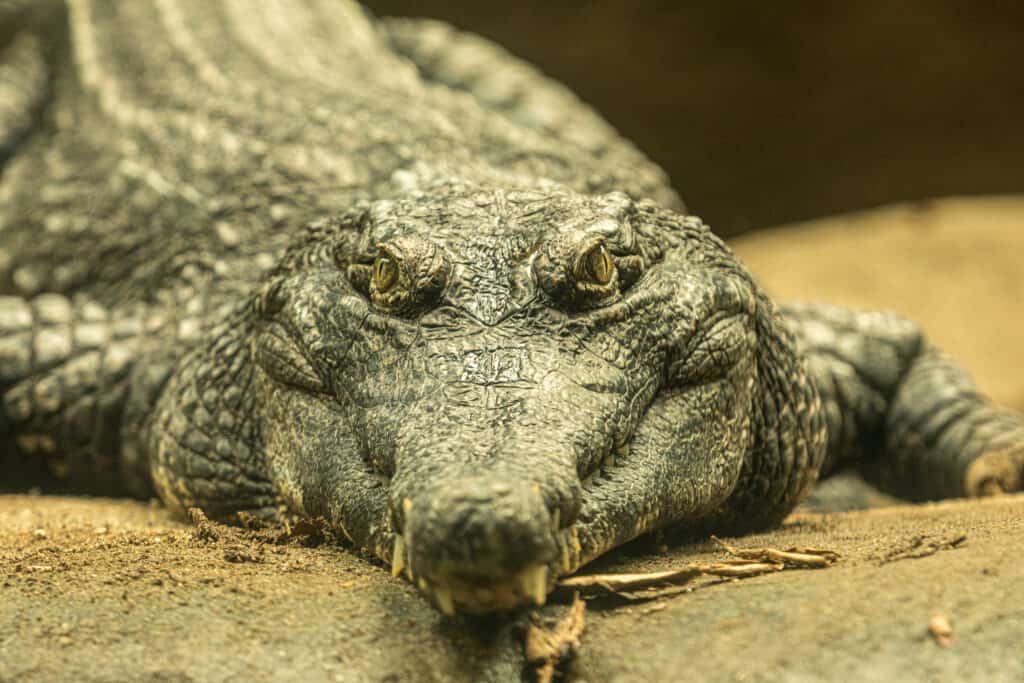
African
Crocodile
lives in freshwater habitats in Central and West Africa. It can grow up to 13 feet long and 500 pounds.
©BrittanyO/Shutterstock.com
Of all the reptiles found in the Congo River, the West African crocodile is one of the most deadliest. Very similar and often confused with the more aggressive Nile crocodile, this reptile is smaller, growing to lengths of between 5 to 8 feet, and is found in sacred pools where they are worshipped by the local people. Also referred to as the sacred and the desert crocodile, these nocturnal, ambush predators hunt by waiting for their prey to come closer, then rush out to attack. They have a slow metabolism, as they are ectothermic predators, and this ables them to go long periods of time without food.

Leatherback sea turtles are the largest turtle species in the world.
©Been there YB/Shutterstock.com
The Congo River is home to several large species of reptiles including the largest turtle, which is the leatherback. This is the heaviest of the non-crocodilian reptiles, with weights ranging from 550 to 1,500 pounds, and can reach lengths of between 6 to 7.2 feet. The only species of turtle that lacks scales and a hard shell, this animal was in fact named after its shell, which is leather-like, and unlike many other reptiles, they are not cold-blooded and have the ability to maintain their body temperature up to 64 degrees, allowing them not only to enter cold waters but also gives them the largest global range of any reptile.
The photo featured at the top of this post is © Danita Delimont/Shutterstock.com
Discover the "Monster" Snake 5X Bigger than an Anaconda
Every day A-Z Animals sends out some of the most incredible facts in the world from our free newsletter. Want to discover the 10 most beautiful snakes in the world, a "snake island" where you're never more than 3 feet from danger, or a "monster" snake 5X larger than an anaconda? Then sign up right now and you'll start receiving our daily newsletter absolutely free.
Thank you for reading! Have some feedback for us? Contact the AZ Animals editorial team.






